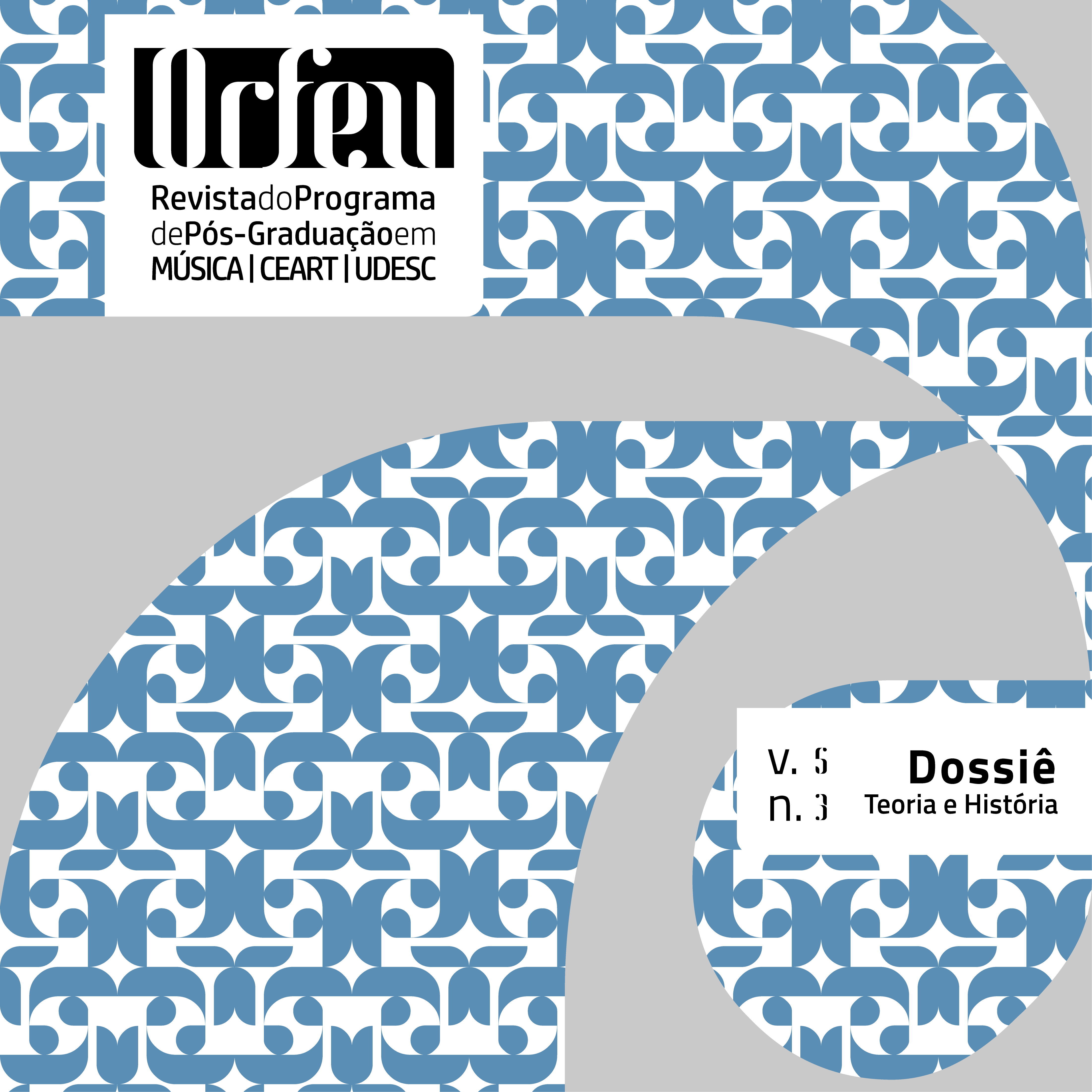DEVICES OF THE MELODIC INVENTION ACCORDING TO JOHANN MATTHESON (1739)
DOI:
https://doi.org/10.5965/2525530405032020076Keywords:
commonplaces, invention, musical rhetoric, Johann Mattheson, Musica poeticaAbstract
Between the 16th and 18th Centuries, the reformed Lutheran world produced texts that have in common the systematical use of the terminology derived from classical rhetoric and poetics to describe musical phenomena. Certainly, the most comprehensive and detailed of these works is the writing by Johann Mattheson, entitled Der vollkommene Capellmeister [“The perfect master-of-chapel”], published in 1739.
This article deals with the chapter of Mattheson’s work dedicated to melodic invention, described as the first part of the construction of musical discourse, presents its parts and finally discusses the commonplaces, sources of arguments for invention of musical themes. In presenting Mattheson’s ideas about invention, we intend, in addition to making the content of the text known, to highlight the rhetorical basis of his writings and defend the utility of commonplaces as tools for musical composition in the 17th and 18th Centuries.
Downloads
References
ARLT, Wulf. Zur handhabung der inventio in der deutschen Musiklehre des frühen achtzehnten Jahrhunderts. In: BUELOW, George und Hans-Joachim Marx. New Mattheson Studies. Cambridge: Cambridge University Press, 1983. p. 371-391.
BARROS, Cassiano de Almeida. A teoria fraseológico-musical de H.C. Koch (1749-1816). Tese (Doutorado em Música) - Universidade Estadual de Campinas, Campinas, 2011. Disponível em: http://repositorio.unicamp.br/bitstream/REPOSIP/284457/1/Barros_CassianodeAlmeida_D.pdf. Acesso em: 31 out. 2018.
BLUTEAU, Raphael. Vocabulario Portuguez & Latino (1712-1728). Coimbra: Collegio das Artes da Companhia de Jesu, 1712-1728. 8 v. Disponível em: http://www.ieb.usp.br/online/index.asp. Acesso em: 23 jan. 2019.
BROSSARD, Sebastién de. Dictionnaire de Musique. Amsterdam: Estienne Roger, c.1708. Disponível em: https://imslp.org/wiki/Dictionnaire_de_musique_(Brossard%2C_S%C3%A9bastien_de). Acesso em: 23 nov. 2019.
BURMEISTER, Joachim. Musica Poetica (Rostock, 1606). Laaber: Laaber, 2004.
CÍCERO, Marco Túlio. De Inventione. London: Harvard University Press, 1949 [87 a.C.] (Loeb Classical Library).
https://doi.org/10.4159/DLCL.marcus_tullius_cicero-de_inventione.1949
CÍCERO, Marco Túlio. De Oratore. London: Harvard University Press, 1942 (Loeb Classical Library).
https://doi.org/10.4159/DLCL.marcus_tullius_cicero-de_oratore.1942
CÍCERO, Marco Túlio. Do Orador. In: SCATOLIN, Adriano. A invenção no Do Orador de Cícero: um estudo à luz de Ad familiares, I, 9, 23. Tese (Doutorado em Letras) - Universidade de SãoPaulo, São Paulo, 2009. Disponível em https://www.teses.usp.br/teses/disponiveis/8/8143/tde-19022010-165443/pt-br.php . Acesso em: 23. Nov. 2019
[CÍCERO]. Retórica a Herênio [Rhetorica ad Herennium]. São Paulo: Hedra, 1995. Disponível em: http://imslp.eu/files/imglnks/euimg/f/fd/IMSLP484218-PMLP249427-_56aa-PMLP12576-Dietrich_Buxtehude_-_S%C3%A4mtliche_Orgelwerke_(Hedar),_ Vol._4_(music_only),_as_scanned.pdf. Acesso em: 6 out. 2019.
CORELLI, Arcangelo. Sonata op. 5 n. 1. Rome: Gasparo Pietra Santa, s.d. [1700]. Disponível em: http://conquest.imslp.info/files/imglnks/usimg/3/3a/IMSLP526383-PMLP639906-corelli_op5_no1.pdf. Acesso em: 3 maio 2019.
DONI, Giovanni Battista. De praestantia musicae veteris. Florentia: Foroliuien, 1647. Disponível em: https://books.google.com.ar/books?id=w-tCAAAAcAAJ&pg=RA3-PP3&lpg=RA3-PP3&dq=donius+de+praestantia&source=bl&ots=ktSjQEq3Js&sig=0oeeXuhW81Ow2Hinr8ZFI35GHV8&hl=pt-BR&sa=X&ved=2ahUKEwjYwd7r_rjeAhUHjJAKHdlTA64Q6AEwAnoECAUQAQ#v=onepage&q=donius%20de%20praestantia&f=false. Acesso em: 2 set. 2018.
DREYFUSS, Laurence. Bach and the Patterns of Invention. Harvard: Harvard University Press, 2004.
HAYDN, Joseph. Quartetos de cordas op. 33. Leipzig: Ernst Eulenburg, 1960. Disponível em: http://conquest.imslp.info/files/imglnks/usimg/0/01/IMSLP455448-PMLP12766-Op33_comb.pdf. Acesso em: 30 jan 2019.
HEINICHEN, Johann David. Der Generalbass in der Composition. Laaber [Dresden]:Laaber Verlag [o autor], 2005 [1728].
HILLER, Johann Adam. Kritischer Entwurf einer musikalischen Bibliothek. In: HILLER, Johann Adam. Wöchentliche Nachrichten und Anmerkungen an die Musik betreffend. Leipzig: Verlag der Zeitungs-Expedition, 1768 (4 e 18 jul. 1768). p. 1-7. Disponível em: https://reader.digitale-sammlungen.de/de/fs1/object/display/bsb10271143_00007.html. Acesso em: 12 fev. 2020.
HUNOLD, Christian Friedrich. Die allerneueste Art, zur Reinen und Galanten Poesie zu gelangen. Hamburg: Fickweiler [Liebernickel], 1722 [1709]. Disponível em: https://reader.digitale-sammlungen.de/de/fs1/object/display/bsb10111718_00005.html. Acesso em: 20 jun. 2018.
INVENÇÃO. In: DICIONÁRIO Caldas Aulete. [S. l.]: Lexicon, [s.d.]. Disponível em: http://www.aulete.com.br. Acesso em: 30 set. 2018.
KIRCHER, Athanasius. Musurgia Universalis sive Ars magna Consoni et Dissoni. Hildesheim [Roma]: Georg Olms, 1999 [1650].
KOCH, Heinrich Cristoph. Musikalisches Lexikon. Kassel [Frankfurt am Main]: Bärenreiter [August Hermann der Jüngere], 2001.
LUCAS, Monica. O lugar-comum arte-natureza em Der vollkommene Capellmeister ["o mestre-de-capela perfeito", 1739], de Johann Mattheson. Trans-forma-ação, Unesp, v. 39, n. 1, p. 35-72, 2016.
https://doi.org/10.1590/s0101-31732016000500006
MATTHESON, Johann. Critica Musica. Hamburg: der Author, 1722-1725. Disponível em: https://reader.digitale-sammlungen.de/de/fs1/object/display/bsb10527428_00005.html. Acesso em: 3 nov. 2017.
MATTHESON, Johann. Das Neu-Eröffnete Orchestre (Hamburg, 1713). Laaber: Laaber Verlag, 2004.
MATTHESON, Johann. Der Vollkommene Capellmeister (Hamburg, 1739). Kassel: Bärenreiter, 1991.
MATTHESON, Johann. Exemplarische Organistenprobe. Hamburg: Schiller und Kissner, Disponível em: https://reader.digitale-sammlungen.de/de/fs1/object/display/bsb10527431_00023.html. Acesso em: 2 maio 2018.
QUINTILIANO, Marco Fabio. Instituição Oratória [Institutio Oratoria]. Campinas: Edunicamp, 2015.
RIPA, Cesare. Iconologia or Moral Emblems. London: Tempest, 1709. Disponível em: http://dinamico2.unibg.it/ripa-iconologia/edizioni.html#ed_18. Acesso em: 2 jul. 2018.
SCHEIBE, Adolf. Der Critische Musicus. Hamburg: Beneke, 1738. Disponível em: https://reader.digitale-sammlungen.de/resolve/display/bsb10599388.html. Acesso em: maio 2018.
SARAIVA, Francisco Rodrigues dos Santos. Novíssimo Dicionário Latino Português. São Paulo [Le Havre]: Garnier/Martins Fontes [Garnier], 2000 [1881].
SPIESS, Meinad. Tractatus Musico-Practicus. Augsburg: Johann Grossens Erben, 1745. Disponível em: https://imslp.org/wiki/Tractatus_Musicus%2C_Op.8_(Spie%C3%9F%2C_Meinrad). Acesso em: 2 ago. 2019.
STEBLIN, Rita. A History of Key Characteristics in the 18th and Early 19th Centuries. Rochester: University of Rochester Press, 2005 [1983].
TATLOW, Ruth. Bach and the riddle of the number alphabet. Cambridge: Cambridge Universtity Press, 1991.
VIDEIRA, Mário Rodrigues. Schiller, Körner e a questão da estética musical. In: SILVA, F. M. F.; MARQUES, U. R. de A. (org.). Arte & Filosofia. Lisboa: Centro de Filosofia da Universidade de Lisboa, 2019. p. 97-117.
WEISE, Christian. Curieuse Fragen über die Logica. Leipzig: Johann Grossens Erben,
WEISSENBORN, Christoph. Gründliche Einleitung zur Teutschen und Lateinischen Oratorie. Frankfurt und Leipzig: Christian Pohl, 1713. Disponível em: http://reader.digitale-sammlungen.de/de/fs1/object/display/bsb11081452_00005.html. Acesso em: ago. 2019.
ZEDLER, Johann Heinrich. Grosses vollständiges Universal-Lexikon. Leipzig: der Author, 1731-1754. Disponível em: http://www.zedler-lexikon.de/. Acesso em: 15 set. 2018.
Downloads
Published
How to Cite
Issue
Section
License
Copyright (c) 2020 ORFEU

This work is licensed under a Creative Commons Attribution 4.0 International License.
Authors who submit their manuscripts to be published in this journal agree to the following terms:
1. Authors retain the copyright and grant to the journal the right of first publication, whilst simultaneously permitting their work to be licensed under the Creative Commons License Attribution, which allows the sharing of work with recognition of the authorship and initial publication in this journal.
2. Contributions in this journal are open access; this means they are based in free use, and non-commercial applications.






